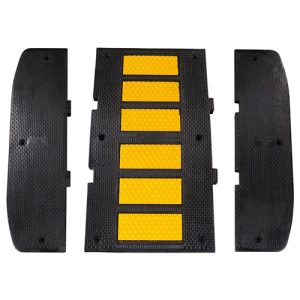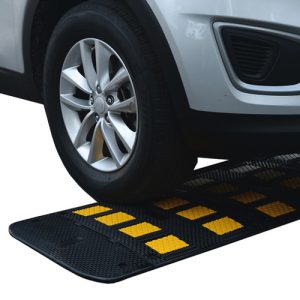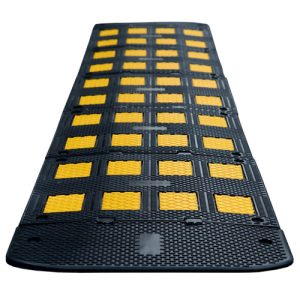Our heavy-duty economy speed bump measurement for each middle section length is 72″ and weighs around 48 lbs. These middle sections can be joined with end caps to form a complete speed bump. They are easily cut to custom lengths to fit any area, also they are weather and chemical resistant. There are many benefits from this great product, some of them are:

Heavy-duty economy speed bump
When to use Speed Bumps?
We use speed bumps in parking lots where speeds are 5-10 MPH. On our non-arterial streets we use what are called “speed humps,” and here’s the confusing part – they are commonly known as “speed bumps” by the public and are identified by signs as being speed “bumps” even though they aren’t. Speed humps extend the full width of a street. They are actually longer (12’ long) and less aggressive (3” high mounds) than speed bumps, and are made to reduce speeds on our non-arterial residential streets. They are not suitable for arterials streets or on all non-arterial residential streets.

Heavy-duty economy speed bump
6’ Economy Recycled Rubber Heavy Duty Speed Bump
| SKU | Description | Length | Height | Width | Weight |
|---|---|---|---|---|---|
| SB206FT | 6 Ft Speed Bump (1) 6′ Section With no End Caps | 72″ | 2″ | 12″ | 48.40 |
| SB207FT | 7 Ft Speed Bump (1) 6′ Section + (2) End Caps | 86″ | 2″ | 12″ | 55.40 |
| SB213FT | Single Lane 12 Ft Speed Bump (2) 6′ Section With no End Caps | 144″ | 2″ | 12″ | 96.80 |
| SB219FT | Double lane 19 Ft Speed Bump (3) 6′ Section + (2) End Caps | 230″ | 2″ | 12″ | 152.20 |
| SB225FT | 25 Ft Speed Bump (4) 6′ Section + (2) End Caps | 302″ | 2″ | 12″ | 200.60 |
| SB2ECAP | End cap | 7′ | 2′ | 12′ | 3.50 |
Premium Recycled Rubber Safety-Striped Speed Hump – Reflective Rubber
| SKU | Description | Length | Height | Width | Weight |
|---|---|---|---|---|---|
| SB3039I | 39″ Speed Bump (1) 39″ Section With no End Caps | 39″ | 2″ | 13.7″ | 36.20 |
| SB3117I | 117″ Single Lane Speed Bump (3) 39″ Sections With no End Caps | 117″ | 2″ | 13.7″ | 108.60 |
| SB3137I | 137″ Single Lane Speed Bump (3) 39″ Sections + (2) End Caps | 137″ | 2″ | 13.7″ | 124.20 |
| SB3234I | 234″ Double lane Speed Bump (6) 39″ Sections With no End Caps | 234″ | 2″ | 13.7″ | 217.20 |
| SB3254I-2 | 254″ Double Lane Speed Bump (6) 39″ Sections + (2) End Caps | 254″ | 2″ | 13.7″ | 232.80 |
| SB3ECAP-2 | End cap | 10″ | 2″ | 13.7″ | 7.80 |
Recycled Rubber Speed Hump – Yellow / Black Single Lane or Double Lane
| SKU | Description | Length | Height | Width | Weight |
|---|---|---|---|---|---|
| SH1018I | 18.75″ Speed Bump (1) 18.75″ Section with no End Caps | 18.75″ | 1.25″ | 2″ | 22.20 |
| SH1112I | 112.5″ Single Lane Speed Bump (6) 18.75″ Sections with no End Caps | 112.5″ | 1.25″ | 2″ | 133.20 |
| SH1128I | 10 Ft Single Lane Speed Bump (6) 18.75″ Sections + (2) End Caps | 128.5 | 1.25″ | 2″ | 148.80 |
| SH1225I | 225″ Double Lane Speed Bump (12) 18.75″ Sections with no End Caps | 225″ | 1.25″ | 2″ | 266.40 |
| SH1241I | 20 Ft Double Lane Speed Bump (12) 18.75″ Sections + (2) End Caps | 241″ | 1.25″ | 2″ | 282.00 |
| SH1ECAL | LEFT End Cap | 8″ | 1.25″ | 2′ | 7.80 |
| SH1ECAR | RIGHT End Cap | 8″ | 1.25″ | 2′ | 7.80 |
Heavy Duty Rubber Speed Hump – Yellow / Black – Low Profile Speed Bump
| SKU | Description | Length | Height | Width | Weight |
|---|---|---|---|---|---|
| SH2019I | 19.75″ Speed Bump (1) 19.75″ Section With no End Caps | 19.75″ | 2″ | 3″ | 48.00 |
| SH2121I | 10 Ft Single Lane Speed Bump (5) 19.75″ Sections + (2) End Caps | 121.75″ | 2″ | 3″ | 273.00 |
| SH2240I | 20 Ft Double Lane Speed Bump (11) 19.75″ + (2) End Caps | 240″ | 2″ | 3″ | 561.00 |
| SH2ECAL | LEFT End cap | 11.5″ | 2″ | 3′ | 16.00 |
| SH2ECAR | RIGHT End cap | 11.5″ | 2″ | 3′ | 16.00 |
What benefits Speed Bumps have?
Parking lots are not the place to go very fast, which is why your facility’s lots need the help of speed bumps and humps. Speed control and proper traffic enforcement is not only good policy; it’s the law and a critical aspect of regulatory compliance. Any facility, work site or office space with a substantial amount of parking space will need to use speed bumps and humps to control the multitude of vehicles that enter and exit their lots on a daily basis.

Heavy-duty economy speed bump
Are we manufacturers?
Unimat Traffics is a Manufacturer company that is why we have the best prices and we also have different packages for Distributors and Suppliers, you can single units or Wholesale. Our company clients all over the world, we are fully stocked and can ship right away. Our customer service representatives are always ready to assist you and can answer any technical and specific questions. We are a company with the best service, ship response and the lowest prices of the market.
Do you want to buy this product at the best price?
Call now our Sales Department and we will be happy to assist you!

